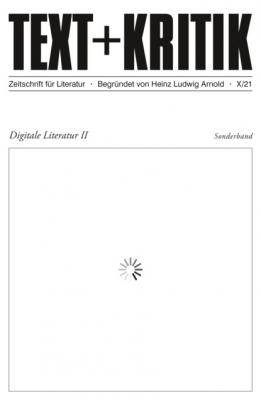Скачать книгу
Kinetische Poesie – Interaktive Installation. Zum Verstehen von Kunst in digitalen Medien«, Bielefeld 2012. —
3 Das Projekt »Science Data Center für Literatur« SDC4Lit des DLA Marbach in Verbindung mit der Universität Stuttgart (
https://www.sdc4lit.org, 31.5.2021) setzt die Bemühungen des DLA Marbach um die Sammlung »Netzliteratur« fort. —
4 Vgl. die Einschätzung Blocks von 2015: Block: »p0es1s«, a. a. O., S. 24. —
5 Toni Bernhart: »Rul Gunzenhäuser und die Stuttgarter Schule der mathematischen Geisteswissenschaften«, in: Andrea Albrecht / Masetto Bonitz / Alexandra Skowronski / Claus Zittel (Hg.): »Max Bense. Werk – Kontext – Wirkung«, Berlin 2019, S. 323–335; Davide Giuriato / Martin Stingelin / Sandro Zanetti (Hg.): »›System ohne General‹. Schreibszenen im digitalen Zeitalter«, München 2006; Renate Giacomuzzi: »Deutschsprachige Literaturmagazine im Internet. Ein Handbuch«, Innsbruck 2012. —
6 Dene Grigar / James O’Sullivan (Hg.): »Electronic Literature as Digital Humanities. Contexts, Forms, and Practices«, London, Oxford 2021. —
7 Clara Chetcuti: »Electronic Literature«, in: »Electronic Literature Directory«, ELO, 10.1.2020,
https://www.directory.eliterature.org/e-lit-resource/5183 (31.5.2021). —
8 Espen Aarseth: »Cybertext. Perspectives on Ergodic Literature«, Baltimore 1997. S. 1–2. —
9 Jaromil: »forkbomb«, 2002; Cramer: »Exe.cut[up]able statements«, a. a. O., S. 258 f. —
10 Hannes Bajohr: »Schreibenlassen. Gegenwartsliteratur und die Furcht vorm Digitalen«, in: »Merkur« 782 (2014), S. 651–658. —
11 Etwa Stefanie Sargnagels »Statusmeldungen«, Hamburg 2017, vgl. die Beiträge von Elias Kreuzmair, Niels Penke, Berit Glanz und Sarah Berger in diesem Band. Als Beispiele gesellschaftlicher, medialer und historischer Plattform-Reflexion vgl. 0x0a: »Die Sprache Pegidas«, Hannes Bajohr / Gregor Weichbrodt: »Glaube Liebe Hoffnung«, 2015,
https://0x0a.li/de/die-sprache-pegidas/;
https://0x0a.li/de/text/glaube-liebe-hoffnung (31.5.2021); Beat Suter / René Bauer: »Turing’s Assembly Line«, 2020,
https://turingsal.and-or.ch/ (31.5.2021). —
12 0x0a (Hg.): »Poetisch Denken« I-IV (Monika Rinck, Jan Wagner, Ann Cotten, Steffen Popp), Berlin 2020. —
13 N. Katherine Hayles: »Electronic Literature: What Is it?«, ELO, 2.1.2007, URL:
https://eliterature.org/pad/elp.html (31.5.2021). —
14 N. Katherine Hayles: »Print Is Flat, Code Is Deep. The Importance of Media-Specific Analysis«, in: »Poetics Today« 25 (2004), S. 67–90. —
15 N. Katherine Hayles: »Electronic Literature. New Horizons for the Literary«. Notre Dame, Ind. 2008, S. 4. —
16 Noah Wardrip-Fruin: »Five Elements of Digital Literature«, in: Roberto Simanowski / Jörgen Schäfer / Peter Gendolla (Hg): »Reading Moving Letters«, Bielefeld 2010, S. 29–58, hier S. 29. —
17 Philippe Bootz: »Digital Poetry. From Cybertext to Programmed Forms«, in: »Leonardo Electronic Almanac« 14 (2006),
https://www.leoalmanac.org/wp-content/uploads/2012/09/04Digital-Poetry-From-Cybertext-to-Programmed-Forms-by-Philippe-Bootz-Vol-14-No-5-6-September-2006-Leonardo-Electronic-Almanac.pdf (31.5.2021). —
18 Ebd. —
19 Block: »p0es1s«, a. a. O., S. 34. —
20 Florian Cramer: »What Is ›Post-digital‹?«, in: David. M. Berry / Michael Dieter (Hg.): »Postdigital Aesthetics«, London 2015, S. 12–28; Sandy Baldwin: »The Internet Unconscious. On the Subject of Electronic Literature«, London, Oxford 2016, S. 45. —
21 Lori Emerson: »Reading Writing Interfaces. From the Digital to the Bookbound«, Minneapolis 2014, S. 24 ff. —
22 Johanna Drucker: »Performative Materiality and Theoretical Approaches to Interface«, in: »Digital Humanities Quarterly« 7 (2013).
http://www.digitalhumanities.org/dhq/vol/7/1/000143/000143.html (1.6.2021); Jean-François Blanchette: »A Material History of Bits«, in: »Journal of the American Society for Information Science and Technology« 62 (2011), S. 1042–1057. —
23 Cramer: »Exe.cut[up]able statements«, a. a. O.; Perl Poetry: S. 254–255, »jabberwocky.pl«: S. 256–258. Original-URL:
https://www.perlmonks.org/index.pl?node_id=111157 (31.5.2021). —
24 Nick Montfort: »All the Names of God«, »Alphabet Expanding«, »ASCII Hegemony«, »Letterformed Terrain«, 2017, URL:
https://nickm.com/poems/concrete_perl (31.5.2021). —
25 Larry Wall / Tom Christiansen / Jon Orwant: »Programming Perl«, 3. Aufl., Boston 2000, 27.2. Perl Poetry. —
26 https://www.perlmonks.org;
https://www.perlmonks.org/?node=Andreychek (31.5.2021). —
27 Nick Montfort: »Eli«, Twitter, 24.3.2021,
https://twitter.com/nickmofo/status/1374802586725941248?s=20 (31.5.2021). —
28 Vienna Code Poetry Slam;
https://codepoetry.at(1.6.2021). —
29 Die Modelle Hayles’ und Flores’ scheinen problematischerweise zu implizieren, dass die Generationen sich in einer Fortschrittsbewegung gegenseitig ablösen (siehe den Beitrag von Bajohr und Gilbert in diesem Band). Zudem erweist sich das definitorische Übergewicht mediengeschichtlicher Aspekte der Bildschirmperformanz (Internet, Hypertext) zu Lasten anderer Systematisierungen als ebenso wenig hilfreich wie die Begrenzung auf eine westliche Erfahrung mit digitaler Technologie und Kunst. Vgl. Hayles: »Electronic Literature«, a. a. O.; Leonardo Flores: »Third-Generation Electronic Literature«, in: Grigar / O’Sullivan (Hg.): »Electronic Literature as Digital Humanities«, a. a. O., S. 26–43; Thangavel Shanmugapriya / Nirmala Menon: »First and Second Waves of Indian Electronic Literature«, in: »Journal of Comparative Literature and Aesthetics« 42 (2019), S. 63–71. —
30 Bernhart: »Rul Gunzenhäuser«, a. a. O. Max Bense war 1933–34 Mitglied der SA, ab 1937 Mitglied der NSDAP. Vgl. Andrea Albrecht / Christian Blohmann / Lutz Danneberg: »›Mathematik ist reine Wissenschaft, nichts anderes‹. Max
Скачать книгу

